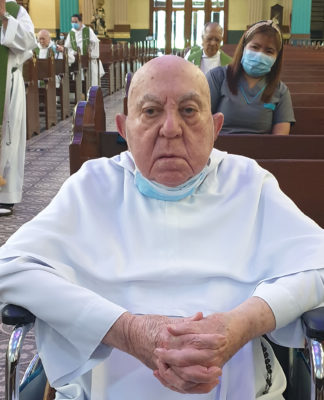BEING “earthquake-proof” aside, the UST Main Building may not last another century as chemical elements are slowly chipping away at its foundation.
That’s the concern of UST cum laude graduate Hayden Gil. She examined the structural integrity of the heritage building in a chemical approach and found enough reasons to be wary.
In her undergraduate thesis, Gil chemically examined the integrity of the 78-year old structure, and found it in “good” condition, but measures for its conservation “have to be devised as soon as possible.”
“Visual observation of the outside walls of the UST Main Buil-ding shows evidence of discoloration, black incrustations, and growth of small plants. The base moldings attached around the Building are chipping off and some rebars have already corroded. Fissures, cracks, and some fractures can also be found inside,” Gil said. “These signs of deterioration are actually inevitable for any 78-year-old edifice,” she added.
She studied the stone samples to determine the proper materials needed for the rehabilitation of the building’s damaged parts.
“The findings of this study are deemed crucial in the selection of compatible materials to be used in the future rehabilitation of the damaged parts of the Main Building. Likewise, such findings may be useful in the preparation and implementation of the UST Main Building Conservation Management Plan,” Gil said.
Gil subjected fragments from different parts of the building to the American Standard Test Methods, a method used to determine chloride, sulfate and cement contents.
According to the study, chloride, a component of salts, is weakening the Main Building’s surface on a microscopic level due to corrosion of the steel reinforcement. Sulfate has also penetrated the concrete, causing volume expansions, which have further caused internal stress, leading to further cracks and breaks. Since concrete is alkaline in nature, its long-term durability weakens.
The study also found out that concrete materials used on the ground floor were different from those used in the upper levels, as chemical contents vary significantly.
Tests for sulfate content on the tower were exceptionally high compared to the rest of the building due to air pollution of sulfur oxide gases in the air, said Dr. Fortunato B. Sevilla III, dean of the College of Science and Gil’s thesis adviser.
Nevertheless, Gil said the inner core of the building is stronger than the outer façade.
“The thesis is the first study of its kind and will probably be studied further. But it gives you an idea on the possible effect of the environmental conditions the building encounters,” Sevilla said.
People may see the Main Building intact and proudly standing, but people don’t know what might happen to it, Sevilla said.















